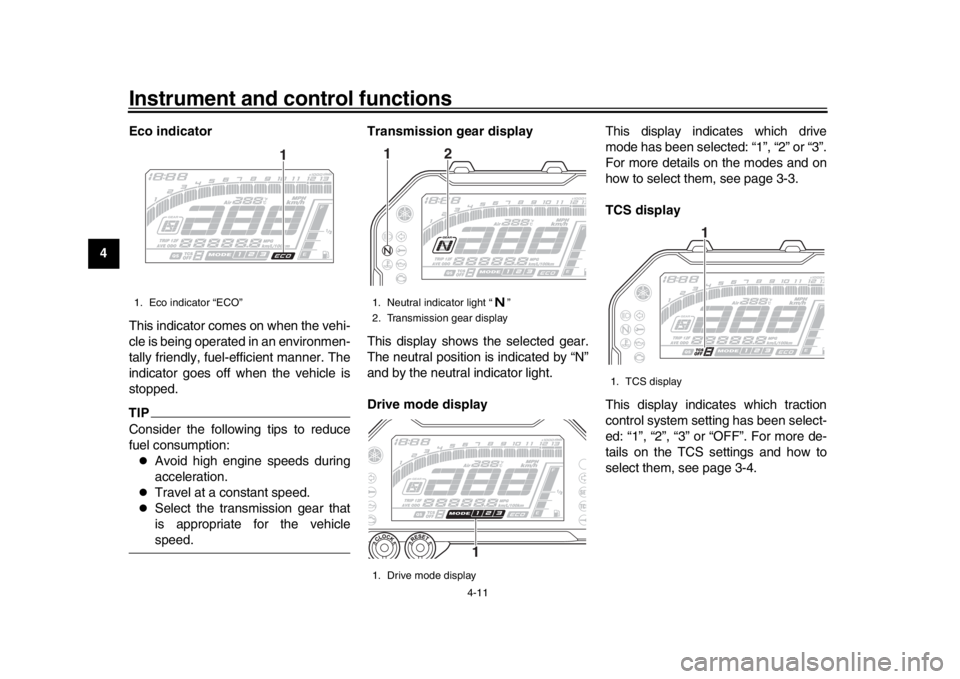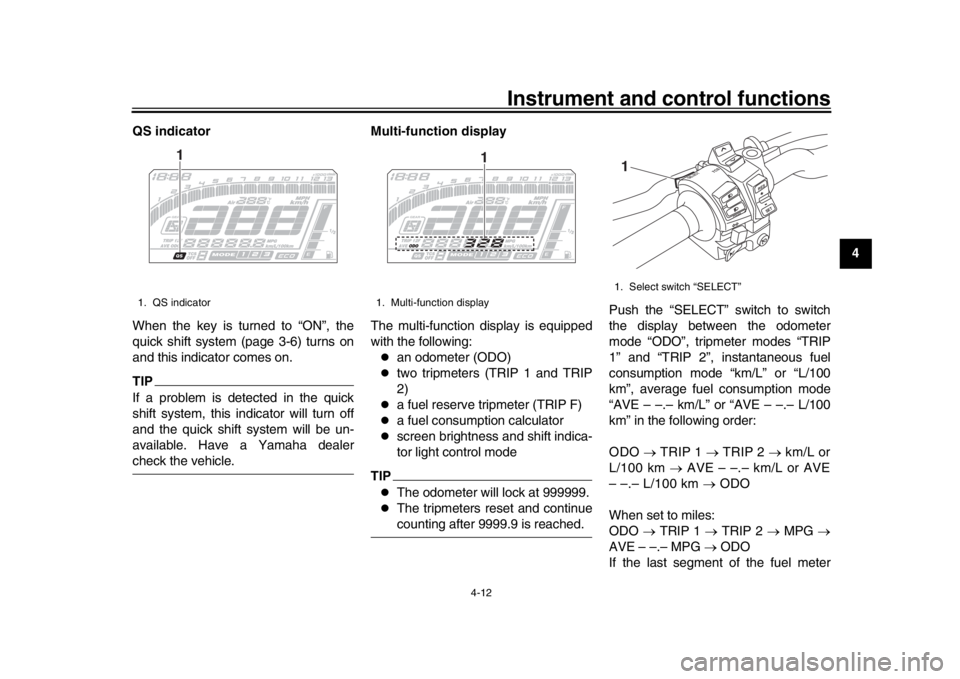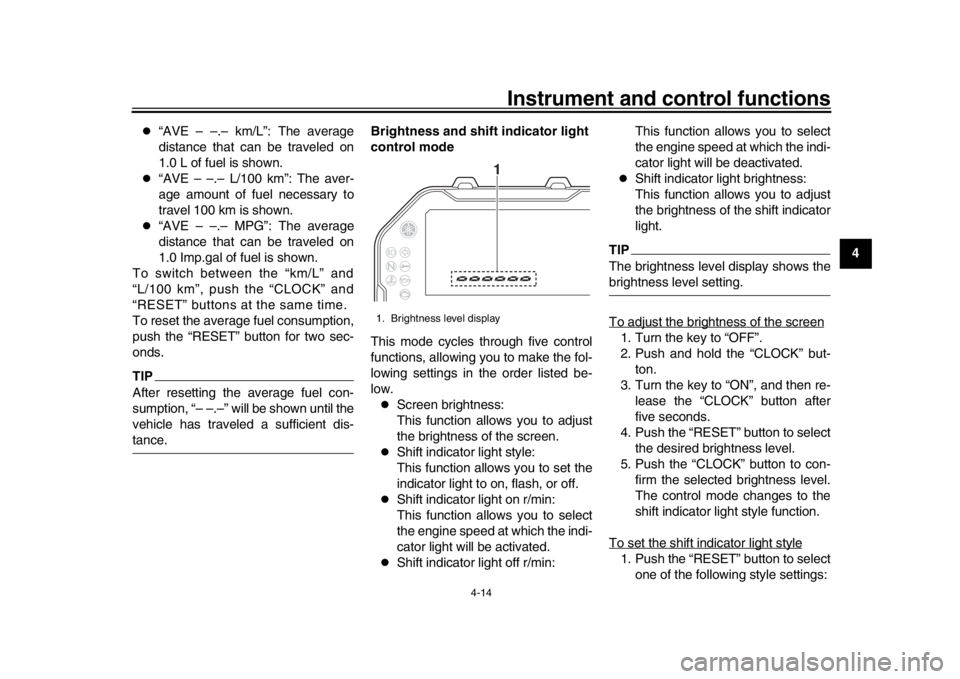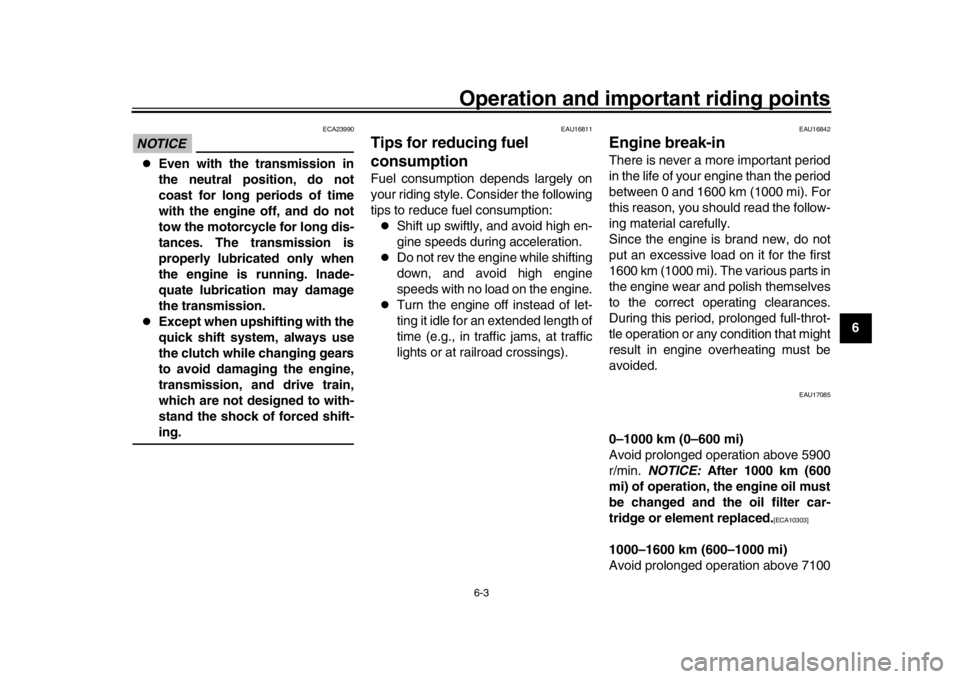fuel consumption YAMAHA MT-10 2020 Owners Manual
[x] Cancel search | Manufacturer: YAMAHA, Model Year: 2020, Model line: MT-10, Model: YAMAHA MT-10 2020Pages: 108, PDF Size: 9.22 MB
Page 6 of 108

Table of contentsSafety information........................... 1-1
Description ....................................... 2-1
Left view ......................................... 2-1
Right view ....................................... 2-2
Controls and instruments................ 2-3
Special features ............................... 3-1
Cruise control system ..................... 3-1
D-mode (drive mode)...................... 3-3
Traction control system .................. 3-4
Quick shift system ...... .................... 3-6
Instrument and control
functions ........................................... 4-1
Immobilizer system ..... .................... 4-1
Main switch/steering lock................ 4-2
Handlebar switches ........................ 4-3
Indicator lights and warning lights ............................................ 4-5
Multi-function meter unit ................. 4-8
Clutch lever................................... 4-16
Shift pedal..... ............................ .... 4-16
Brake lever ................................... 4-16
Brake pedal .................................. 4-17
ABS .............................................. 4-17
Fuel tank cap ................................ 4-18
Fuel............................................... 4-19
Fuel tank overflow hose................ 4-21
Catalytic converter ........................ 4-21
Seat .............................................. 4-22 Adjusting the front fork ................. 4-22
Adjusting the shock absorber
assembly................................... 4-24
Luggage strap holders . ................ 4-27
EXUP system ............................... 4-27
Auxiliary DC jack .......................... 4-27
Sidestand ..................................... 4-28
Ignition circuit cut- off system ........ 4-29
For your safety – pre-operation
checks .............................................. 5-1
Operation and important riding
points ................................................ 6-1
Starting the engine ......................... 6-1
Shifting ........................................... 6-2
Tips for reducing fuel consumption ............................... 6-3
Engine break-in .............................. 6-3
Parking ........................................... 6-4
Periodic maintenance and
adjustment ....................................... 7-1
Tool kit............................................ 7-2
Periodic maintenance charts .......... 7-3
Periodic maintenance chart for the emission control system ....... 7-3
General maintenance and
lubrication chart .......................... 7-5
Checking the spark plugs ............... 7-9
Canister ........................................ 7-10 Engine oil ..................................... 7-10
Why Yamalube ............................ 7-14
Coolant ........................................ 7-14
Air filter element ........................... 7-15
Checking the engine idling
speed............ ............................ 7-16
Checking the throttle grip free play ........................................... 7-16
Valve clearance ........................... 7-16
Tires ............................................. 7-17
Cast wheels ................................. 7-19
Adjusting the clutch lever free play ........................................... 7-19
Checking the brake lever free
play ........................................... 7-20
Brake light switches ..................... 7-21
Checking the front and rear
brake pads................................ 7-21
Checking the brake fluid level ...... 7-22
Changing the brake fluid .............. 7-23
Drive chain slack.......................... 7-23
Cleaning and lubricating the drive chain ................................ 7-24
Checking and lubricating the cables ....................................... 7-25
Checking and lubricating the throttle grip and cable ............... 7-25
Checking and lubricating the
brake and shift pedals .............. 7-26
Checking and lubricating the brake and clutch levers ............ 7-26B67-9-E4.book 1 ページ 2019年7月19日 金曜日 午後4時23分
Page 32 of 108

Instrument and control functions
4-11
1
2
34
5
6
7
8
9
10
11
12 Eco indicator
This indicator comes on when the vehi-
cle is being operated in an environmen-
tally friendly, fuel-efficient manner. The
indicator goes off when the vehicle is
stopped.
TIPConsider the following tips to reduce
fuel consumption:
Avoid high engine speeds during
acceleration.
Travel at a constant speed.
Select the transmission gear that
is appropriate for the vehiclespeed.
Transmission gear display
This display shows the selected gear.
The neutral position is indicated by “N”
and by the neutral indicator light.
Drive mode display
This display indicates which drive
mode has been selected: “1”, “2” or “3”.
For more details on the modes and on
how to select them, see page 3-3.
TCS display
This display indicates which traction
control system setting has been select-
ed: “1”, “2”, “3” or “OFF”. For more de-
tails on the TCS settings and how to
select them, see page 3-4.
1. Eco indicator “ECO”
1
1. Neutral indicator light “ ”
2. Transmission gear display
1. Drive mode display12
1
1. TCS display
1
B67-9-E4.book 11 ページ 2019年7月19日 金曜日 午後4時23分
Page 33 of 108

Instrument and control functions
4-12
1
2
345
6
7
8
9
10
11
12
QS indicator
When the key is turned to “ON”, the
quick shift system (page 3-6) turns on
and this indicator comes on.
TIPIf a problem is detected in the quick
shift system, this indicator will turn off
and the quick shift system will be un-
available. Have a Yamaha dealercheck the vehicle.
Multi-function display
The multi-function display is equipped
with the following:
an odometer (ODO)
two tripmeters (TRIP 1 and TRIP
2)
a fuel reserve tripmeter (TRIP F)
a fuel consumption calculator
screen brightness and shift indica-
tor light control mode
TIP
The odometer will lock at 999999.
The tripmeters reset and continuecounting after 9999.9 is reached.
Push the “SELECT” switch to switch
the display between the odometer
mode “ODO”, tripmeter modes “TRIP
1” and “TRIP 2”, instantaneous fuel
consumption mode “km/L” or “L/100
km”, average fuel consumption mode
“AVE – –.– km/L” or “AVE – –.– L/100
km” in the following order:
ODO
TRIP 1 TRIP 2 km/L or
L/100 km AVE – –.– km/L or AVE
– –.– L/100 km ODO
When set to miles:
ODO TRIP 1 TRIP 2 MPG
AVE – –.– MPG ODO
If the last segment of the fuel meter
1. QS indicator
1
1. Multi-function display
1
1. Select switch “SELECT”
R ESSE T
PAS
S
TCS
SELECT
1
B67-9-E4.book 12 ページ 2019年7月19日 金曜日 午後4時23分
Page 34 of 108

Instrument and control functions
4-13
1
2
34
5
6
7
8
9
10
11
12 starts flashing, the display automatical-
ly changes to the fuel reserve tripmeter
mode “TRIP F” and starts counting the
distance traveled from that point. In this
case, push the “SELECT” switch to
switch the display in the following order:
TRIP F
km/L or L/100 km AVE
– –.– km/L or AVE – –.– L/100 km
ODO TRIP 1 TRIP 2 TRIP F
When set to miles:
TRIP F MPG AVE – –.– MPG
ODO TRIP 1 TRIP 2 TRIP F
TIP
To reset a tripmeter, select it by
pushing the “SELECT” switch, and
then push the “RESET” button for
two seconds.
If you do not reset the fuel reserve
tripmeter manually, it resets auto-
matically and disappears after re-fueling and traveling 5 km (3 mi). Instantaneous fuel consumption
mode
The instantaneous fuel consumption
display can be set to either “km/L”,
“L/100 km” or “MPG” (when the
multi-function meter unit has been
set to miles).
“km/L”: The distance that can be
traveled on 1.0 L of fuel under the
current riding conditions is shown.
“L/100 km”: The amount of fuel
necessary to travel 100 km under
the current riding conditions is
shown.
“MPG”: The distance that can be
traveled on 1.0 Imp.gal of fuel un-
der the current riding conditions is shown.
To switch between the “km/L” and
“L/100 km”, push the “CLOCK” and
“RESET” buttons at the same time.
TIPIf traveling at speeds under 20 km/h (12mi/h), “– –.–” is displayed.
Average fuel consumption mode
This display shows the average fuel
consumption since it was last reset.
The average fuel consumption display
can be set to either “AVE – –.– km/L”,
“AVE – –.– L/100 km” or “AVE – –.–
MPG” (when the multi-function meter
unit has been set to miles).
1. Instantaneous fuel consumption display
1
1. Average fuel consumption display
1
B67-9-E4.book 13 ページ 2019年7月19日 金曜日 午後4時23分
Page 35 of 108

Instrument and control functions
4-14
1
2
345
6
7
8
9
10
11
12
“AVE – –.– km/L”: The average
distance that can be traveled on
1.0 L of fuel is shown.
“AVE – –.– L/100 km”: The aver-
age amount of fuel necessary to
travel 100 km is shown.
“AVE – –.– MPG”: The average
distance that can be traveled on
1.0 Imp.gal of fuel is shown.
To switch between the “km/L” and
“L/100 km”, push the “CLOCK” and
“RESET” buttons at the same time.
To reset the average fuel consumption,
push the “RESET” button for two sec-
onds.
TIPAfter resetting the average fuel con-
sumption, “– –.–” will be shown until the
vehicle has traveled a sufficient dis-tance. Brightness and shift indicator light
control mode
This mode cycles through five control
functions, allowing you to make the fol-
lowing settings in the order listed be-
low.
Screen brightness:
This function allows you to adjust
the brightness of the screen.
Shift indicator light style:
This function allows you to set the
indicator light to on, flash, or off.
Shift indicator light on r/min:
This function allows you to select
the engine speed at which the indi-
cator light will be activated.
Shift indicator light off r/min:This function allows you to select
the engine speed at which the indi-
cator light will be deactivated.
Shift indicator light brightness:
This function allows you to adjust
the brightness of the shift indicator
light.
TIPThe brightness level display shows thebrightness level setting.
To adjust the brightness of the screen1. Turn the key to “OFF”.
2. Push and hold the “CLOCK” but-
ton.
3. Turn the key to “ON”, and then re- lease the “CLOCK” button after
five seconds.
4. Push the “RESET” button to select the desired brightness level.
5. Push the “CLOCK” button to con- firm the selected brightness level.
The control mode changes to the
shift indicator light style function.
To set the shift indicator light style1. Push the “RESET” button to select one of the following style settings:
1. Brightness level display
1
B67-9-E4.book 14 ページ 2019年7月19日 金曜日 午後4時23分
Page 57 of 108

Operation and important riding points
6-3
1
2
3
4
567
8
9
10
11
12
NOTICE
ECA23990
Even with the transmission in
the neutral position, do not
coast for long periods of time
with the engine off, and do not
tow the motorcycle for long dis-
tances. The transmission is
properly lubricated only when
the engine is running. Inade-
quate lubrication may damage
the transmission.
Except when upshifting with the
quick shift system, always use
the clutch while changing gears
to avoid damaging the engine,
transmission, and drive train,
which are not designed to with-
stand the shock of forced shift-ing.
EAU16811
Tips for reducing fuel
consumptionFuel consumption depends largely on
your riding style. Consider the following
tips to reduce fuel consumption:
Shift up swiftly, and avoid high en-
gine speeds during acceleration.
Do not rev the engine while shifting
down, and avoid high engine
speeds with no load on the engine.
Turn the engine off instead of let-
ting it idle for an extended length of
time (e.g., in traffic jams, at traffic
lights or at railroad crossings).
EAU16842
Engine break-inThere is never a more important period
in the life of your engine than the period
between 0 and 1600 km (1000 mi). For
this reason, you should read the follow-
ing material carefully.
Since the engine is brand new, do not
put an excessive load on it for the first
1600 km (1000 mi). The various parts in
the engine wear and polish themselves
to the correct operating clearances.
During this period, prolonged full-throt-
tle operation or any condition that might
result in engine overheating must be
avoided.
EAU17085
0–1000 km (0–600 mi)
Avoid prolonged operation above 5900
r/min. NOTICE: After 1000 km (600
mi) of operation, the engine oil must
be changed and the oil filter car-
tridge or element replaced.
[ECA10303]
1000–1600 km (600–1000 mi)
Avoid prolonged operation above 7100
B67-9-E4.book 3 ページ 2019年7月19日 金曜日 午後4時23分
Page 105 of 108

11-1
1
2
3
4
5
6
7
8
9
101112
Index
AABS ...................................................... 4-17
ABS warning light ................................... 4-6
Air filter element.................................... 7-15
Auxiliary DC jack .................................. 4-27BBattery .................................................. 7-29
Brake and clutch levers, checking and lubricating .................................... 7-26
Brake and shift pedals, checking
and lubricating .................................... 7-26
Brake fluid, changing ............................ 7-23
Brake fluid level, checking .................... 7-22
Brake lever ........................................... 4-16
Brake lever free play, checking ............ 7-20
Brake light switches .............................. 7-21
Brake pedal .......................................... 4-17CCables, checking and lubricating .......... 7-25
Canister ................................................ 7-10
Care ........................................................ 8-1
Catalytic converter ................................ 4-21
Clutch lever........................................... 4-16
Clutch lever free play, adjusting ........... 7-19
Coolant ................................................. 7-14
Coolant temperature warning light.......... 4-6
Cruise control indicator lights ................. 4-5
Cruise control switches........................... 4-4
Cruise control system ............................. 3-1DData recording, vehicle ......................... 10-2
Diagnostic connecto r ............................ 10-2
Dimmer/Pass switch ............................... 4-3
D-mode (drive mode).............................. 3-3 Drive chain, cleaning
and lubricating .... 7-24
Drive chain slack ................................... 7-23
Drive mode switch ................................... 4-4
EEngine break-in ....................................... 6-3
Engine idling speed, checking............... 7-16
Engine oil .............................................. 7-10
Engine serial number ............................ 10-1
Engine trouble warning light .................... 4-6
EXUP system ........................................ 4-27FFront and rear brake pads, checking .... 7-21
Front fork, adjusting .............................. 4-22
Front fork, checking............................... 7-28
Fuel ....................................................... 4-19
Fuel consumption, tips for reducing ........6-3
Fuel tank cap......................................... 4-18
Fuel tank overflow hose ........................ 4-21
Fuses, replacing .................................... 7-30HHandlebar switches ................................. 4-3
Hazard switch.......................................... 4-4
High beam indicator light .........................4-5
Horn switch .............................................4-4IIdentification numbers ........................... 10-1
Ignition circuit cut-off system ................. 4-29
Immobilizer system ................................. 4-1
Immobilizer system indicator light ........... 4-7
Indicator lights and warning lights ........... 4-5LLuggage strap holders .......................... 4-27MMain switch/steering lock ........................4-2 Maintenance and lubrication, periodic .... 7-5
Maintenance, emission control
system .................................................. 7-3
Matte color, caution ................................ 8-1
Model label ........................................... 10-2
Multi-function meter unit ......................... 4-8
NNeutral indicator light .............................. 4-5OOil pressure warning light ....................... 4-5PParking.................................................... 6-4
Part locations .......................................... 2-1QQuick shift system................................... 3-6SSafety information ................................... 1-1
Seat ...................................................... 4-22
SELECT switch ....................................... 4-4
Shift indicator light .................................. 4-7
Shifting .................................................... 6-2
Shift pedal ............................................. 4-16
Shock absorber assembly, adjusting .... 4-24
Sidestand .............................................. 4-28
Sidestand, checking and lubricating ..... 7-27
Spark plugs, checking ............................. 7-9
Special features ...................................... 3-1
Specifications.......................................... 9-1
Starting the engine.................................. 6-1
Steering, checking ................................ 7-28
Steering damper warning light ................ 4-7
Stop/Run/Start switch ............................. 4-4
Storage ................................................... 8-4
Supporting the motorcycle .................... 7-34
B67-9-E4.book 1 ページ 2019年7月19日 金曜日 午後4時23分